Friday, 27 January 2012
Wednesday, 25 January 2012
dutch still life
Still Life with Tea Cups (oil on canvas) Artist: Roestraten, Pieter Gerritsz. van (c.1630-1700) Location:
Sheffield Galleries and Museums Trust, UK Medium: oil on canvas Century: C17th Nationality: Dutch
Title: Still life with peaches (oil on canvas) Artist: Spaendonck, Gerard van (1746-1822) Location: Private Collection Medium: oil on canvas Dimensions: 35x45.5 Century: Unknown Nationality: Dutch Description: Nature morte aux peches
Title: A Still Life Artist: Roestraten, Pieter Gerritsz. van (c.1630-1700) Location: Rafael Valls Gallery, London, UK Medium: Unknown Dimensions: Century: C17th Nationality: Dutch Description: Keywords: teapot | violin | covered pot Classification: MUSIC 17TH CENTURY
A Yixing Teapot and a Chinese Porcelain Tete-a-Tete on a Partly Draped Ledge (oil on canvas) Artist: Roestraten, Pieter Gerritsz. van (c.1630-1700) Location: Private Collection Medium: oil on canvas Dimensions: 22.9x28.9
Century: C17th Nationality: Dutch
Wednesday, 18 January 2012
advanced creative enquiry-notes
Multiple yous
'Mrs Monter' by Harold Gilman- a painting of someone drinking tea; 'domesticity' of tea.
Solitary drinker as opposed to a social drinker.
Tea- quaint, old-fashioned quality.
Edward Hopper-'Automat' compare this work to Gilman.
Strong element of the medium; avant-garde.
Social ritual - getting transposed in the technique of making the video- highly managed- peculiar metaphor.
Interplay between the media and primary source.
Have yourself serving yourself tea. You are the person playing the roles and interacting with yourself.
Ritual of the teashop- peculiarly British.
Class aspect of tea.
Self-service or waitress service.
Ethos is very traditional- like another world.
Greasy-spoon cafe- full of cigarette smoke, builders tea, people who inhabit these spaces.
Social inclusion and exclusion in terms of art.
Gendered way.
Pierre Bordeaux - 'Distinction' (social distinctions) and 'Rules of Art'.
Establish differences that are socially based.
Bordeaux critique- serious? or parody?
The idea that sanity depends on ritual.
Too many options- what's most important to you? Focus on your sense of routine; the tea being your source.
Social exclusion idea- very rich and would tie in with your dissertation.
People can be severely intimidated by being in the wrong environment.
Books of etiquette, book of setting-up etiquette. (google), research.
Video yourself giving a lecture, being pedantic about the thing- interesting monologue.
Psychological relationship with tea- YOUR OWN.
Rules- interesting!
Mrs Beaton's, 'Good House-Keeping'.
Friday, 13 January 2012
Jeremy Deller III
The artist who staged an exhibition in his parents' house will be showing works old and new – plus some failed projects
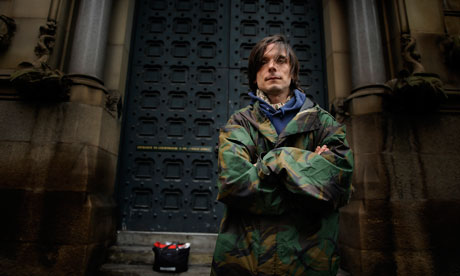
Jeremy Deller, the 2004 Turner prizewinner, will have a retrospective at the Hayward Gallery in London next year. Photograph: Christopher Thomond for the Guardian
When Jeremy Deller sprang on to the national stage as the winner of the 2004 Turner prize – a dandyish figure clad in scarlet jacket and cravat – eyebrows were raised. He had not even taken O-level art at his London public school. Sometimes his work – a re-enactment of the Battle of Orgreave in 1984, one of the fiercest clashes of the miners' strike, or organising the ladies of the Women's Institute to show flower arrangements at the Tate – did not look like art at all.
But now Deller is to have his first retrospective, as well as his first largescale exhibition in London, in February next year. The show at the Hayward Gallery, titled Jeremy Deller: Joy in People, will bring together documents of past collaborative events, films, books and banners.
There will be a restaging of the exhibition he secretly put on in his parents' house in 1993 when they were on holiday (he was 27, still living at home). And the facsimile of a greasy spoon cafe in Bury market called Valerie's, originally made as a float for the parade he organised through Manchester in 2009, will serve free cuppas to visitors.
One person, at least, is bursting with pride: Barbara Deller, the artist's mother, has contributed an essay to the catalogue, My Unconventional Son. In it, she notes that she did not know anything about the 1993 show in her house until a decade later, when she was reading a book by her son that contained "a picture of a toilet that I thought looked remarkably like mine. I read on to realise that it was no coincidence – it was my toilet".
She also notes that "Jeremy's artistic streak was obvious from an early stage" from his "playing Joseph in the school play"; and reveals an early interest in questions of scale. "Our kitchen had to be repainted after he created a 3ft long locust for a school project, only to find everyone else had produced something at actual size," writes Mrs Deller. But not everyone is so appreciative of Deller: "I tried to explain his work to the Queen when Jeremy took me to a reception at Buckingham Palace. I don't think she quite understood, but she was too polite to say."
According to the artist, the show will exhibit mostly work that has never been seen in London before, and Deller is working on new pieces, including "a nature film that I think will be quite visceral and overwhelming as a spectacle". He also promises, darkly, that the museum attendants "will have more of a role than usual".
The exhibition will open with a restaging of Open Bedroom, the show in his parents' house, including the work that he put up in their lavatory – a transcription of the graffiti from the men's toilets at the British Library. "It was a mix of super-brilliant academic minds and super-sexual frustration," he said.
There will be a section on projects that Deller has failed to pull off – "abandoned Olympic projects, an idea for the fourth plinth in Trafalgar Square that was rejected. It's meant to be encouraging. The ideas have often led to something else. And it's human nature to want to see when you've fucked up". The exhibition will be curated by Ralph Rugoff, director of the Hayward. "Deller has opened up more new ways of working than any other artist of his generation – he is a game changer," said Rugoff. "He has always done things in his own way: taking his art into the public realm and doing things that didn't look like art, whether they were bumper stickers or T-shirts."
Acid Brass, a 1997 work in which, at Deller's instigation, a traditional brass band performed arrangements of acid house music, is regarded by Rugoff as "a turning point". He added: "A lot of people work with groups, but it's all very worthy but not that interesting. Jeremy puts his finger on things and touches nerves in the national psyche.
"He's done things in a playful way, with a resonant, big imagination behind his work, that goes way beyond the art world and reaches a much wider audience." He has, according to Rugoff, "brought up questions of value" in his work. Deller emerged after the Young British Artists, who began exhibiting together in 1988, many of them wrapped up in the rising art market and collected by figures such as Charles Saatchi.
He has rarely made work that can be bought or sold straightforwardly. He has, said Rugoff, "heralded a new chapter when artists work as catalysts, producers, curators and collaborators … and with his interest in folk art and the creativity of everyday life he has brought attention to what other people have done".
Jeremy Deller: Joy in People is at the Hayward Gallery on London's South Bank from 22 February to 13 May
Jeremy Deller II
A Dulwich College old boy, he is odds-on favourite to clinch the Turner prize on Monday. In shunning the trendy art scene and 'commodification', he boasts an unusually wide range of admirers, from miners to musicians

Visitors to Dulwich College's website will note that an old boy is hotly tipped to win the Turner prize on Monday. What the school fails to mention is that Jeremy Deller never actually studied art there. "I wasn't so much advised not to take the O level as not allowed to do it. I couldn't draw, paint or sculpt," he recalled this week, without chagrin.
By his own admission, the artist is "not a technically capable person". Yet, at 38, he is not just the youngest but also the favourite of the four Turner nominees to win the prestigious art prize. The bookies pegged him at 7/4 the minute they saw the list. For many admirers, the surprise is that he was not included earlier.
The apparent contradiction between his success and his lack of traditional skills should play into the hands of those who scorn contemporary art; as should the bizarre nature of his projects. At first glimpse, a list of his works might suggest the worst excesses of the cultural elite: a kind of sneering, ironic nod to the working classes. Apparently incompatible sources collide in one-off events or processes, often leaving him with little concrete to show for his work.
How about getting a brass band from Stockport to cover acid house tracks? Or basing an entire exhibition on the work of the Manic Street Preachers, with Lego figures of the rock band and a specially commissioned poem about them by the Eisteddfod bard? Why not stage a reconstruction of the Battle of Orgreave, near Rotherham, perhaps the most vicious and controversial confrontation of the 1984-5 miners' strike?
Deller certainly has his detractors. "No artistic vision ... disgustingly twee, infuriatingly precious, insufferably condescending," the Daily Telegraph's critic Richard Dorment observed of one exhibition. But the artist's sheer passion for his subjects has won him a surprising range of fans.
"His work is hilarious and touching," says the musician David Byrne, who allowed Deller to use the Talking Heads song Heaven in a short film because of his appreciation for the "brilliant" Orgreave event. The sculptor Cornelia Parker, a previous Turner nominee, admires the complexity of his work.
"Warhol said that pop art was about liking things, whereas for me folk art is about loving things," Deller once observed. He describes his career as an accident which resulted from his fascination with the world as a whole and with "low-level creativity", although he has doubtless drawn on art history studies at the Courtauld Institute and Sussex University. While his drawing might leave much to be desired, his academic credentials are impeccable. He held his first "proper" exhibition just 10 years ago, at his parents' house - they were on holiday and only found out after spotting pictures in a book recently. Even now, he is by choice on the fringes of the contemporary art crowd.
"He wanted to engage with things that weren't part of that whole London-centric scene, even though he's a London artist," says Bill Drummond, formerly of the band KLF - who were collaborators on the acid brass project. The passion behind Deller's wide-ranging interests is evident to anyone who meets him, says Andy Gillooly, assistant manager of the Williams Fairey works brass band at the time of the acid brass collaboration.
To picture him as a manipulating metropolitan Svengali is patronising. The band were themselves keen to establish distance from the "flat-cap image" and proposed other tracks. Similarly, former miners queued up to take part in the Orgreave reconstruction. Deller insists that participants are always in on the joke: aware of his work's absurdity as well as its seriousness. "I'm totally uninterested in poking fun at people. It's just too easy," he says.
While almost all his work is overtly political, it evokes instead of lecturing. Though his work is broadly left wing, it is hard to discern a party line and his views seem to be based primarily on honouring the dignity of others.
In Memory Bucket, the film about Texas for which he was nominated this year, he accords as much respect to the manager enthusing about Bush's visits to her coffee shop as he does to the anti-war protesters. The memorials in the Turner show pay tribute with equal sincerity to Brian Epstein, the migrants who arrived on the Empire Windrush, and a cyclist mown down by a dangerous driver. Above all, Deller embraces complexity and is fascinated by connections; a sprawling diagram across one wall of the Tate show relates acid house and brass bands via points including "melancholy", "808 State", "media hysteria", "civic pride", "Ibiza" and "advanced capitalism". "In one sense the connections [he draws] don't really stand up to rigorous investigation," says Bill Drummond.
"But you can remove all that and think 'This is a great thing, coming from his heart'. Even one of his carrier bags or T-shirts has something moving about it."
Matthew Slotover, the editor of the art magazine Frieze and a long-time admirer, says that Deller has the ability to engage almost anyone.
"It's easy to say 'I will bring these things together' and there's an obscure connection there which no one else feels, but when Jeremy does it, it works in a really immediate way to participants and the general public as well as the art crowd," he says.
Tellingly, Deller remains friends with many former collaborators.
"He's an incredibly generous person to work with. He was interested and thought about what I said to him, but really let me go with the flow," says Ed Hall, who made the banner commemorating the Windrush for Deller.
"He takes very commonplace themes and people - including me - and puts them into these grand settings. The people I have mixed with for most of my working life are rail workers, trade union activists; ordinary people on a huge stage - and that is what he taps into.
"He has a lovely manner. He comes across as someone who's really alive and getting on with life. He's a good listener and if he promises something he'll do it. He turns up on time. I can't really think of any weak spots. He's a very nice-looking guy ... I don't even think he smokes," says Mr Hall.
If anything, Deller's Achilles' heel may be his passion. His works are mostly events and processes, which can't be bought and sold. For that reason, the cash attached to the Turner prize is perhaps more important to him than to most contenders, although the £40,000 fund may be split for the first time this year.
"Most people end up producing things for wealthy people or institutions to buy. He's resisted that commodification," says Drummond.
Worse still, Deller hates deadlines and loves long-term projects. The Battle of Orgreave, which involved thousands of participants, took three years to recreate.
Will that commitment be enough to win him the Turner prize? Even admirers warn that he is not a shoo-in, arguing that his work by its nature does not lend itself to an exhibition - although the judges actually base their decision on the artists' recent bodies of work, rather than the show at Tate Britain.
Michael Morris of Artangel, which commissioned the Orgreave reconstruction admits that it is hard to understand quite what Deller does from just one room.
"Anyone would be swept away by one of his happenings," wrote Philip Hensher in the Mail on Sunday. But he argued that "his work is outside galleries, and anything you can show is the detritus after something tremendous".
While the money would undoubtedly be welcome to Deller, the prize itself may be almost irrelevant: he has already achieved the rare feat of making truly popular contemporary art. Not many Turner-nominated artists have dockers, rock stars, miners and mayors crossing fingers for their victory.
Life in short:
Born in London in 1966, and continues to live and work in the capital
In 1988 he completed a BA in art history at the Courtauld Institute of Art in London, specialising in Baroque art and architecture. In 1992 he completed an MA degree in art history at Sussex University
One of his best-known works was the The Battle of Orgreave, which he described as 'a piece of living history', after bringing together veteran miners to restage a clash with the police in 1984-5
His latest series of photographs explores the political heritage of Britain, by commissioning a variety of memorials to individuals and events in recent history
Deller has been shortlisted for the Turner Prize for his installation, Memory Bucket, at ArtPace, San Antonio
Tania Branigan
The Guardian, Friday 3 December 2004 10.33 GMT
Jeremy Deller I
The city threw itself into the Turner prize-winner's Procession, a celebration of the acts of creativity in everyday life
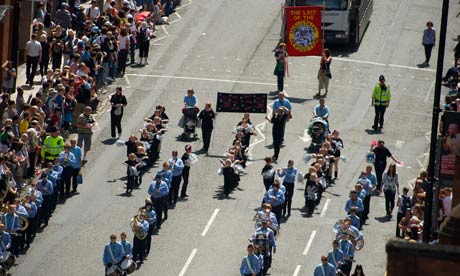
Jeremy Deller's Procession goes down Deansgate in the opening weekend of the Manchester international festival. Photograph: Christopher Thomond
It had everything, from a group of emos and goths to a float exactly re-creating Valerie's caff in Bury Market, complete with its regular customers. It had a gang of Unrepentant Smokers puffing away under a banner designed by David Hockney. It had a camp, elaborate piece of musical theatre created in honour of the earliest fish and chip shop, in Oldham. It gathered together descendants of those present on both sides at Peterloo. It had a Hindu piping band, in full be-kilted regalia, and it had a steel band joyfully playing the mournful songs of Manchester. I wasn't the only one who felt a tear come to my eye as they passed by, ringing out Love Will Tear Us Apart. Jeremy Deller's Procession for theManchester international festival, which wended its way down Deansgate yesterday afternoon, was an absolute joy, a lovely, confident celebration of a city grown-up enough to see itself sidelong and take the mickey out of itself.
If you missed the procession but are passing through Manchester, be sure to go to the exhibition at the Cornerhouse that opens on 9 July. It documents the parade, but also has lots of fascinating material about Manchester's history of mass gatherings and crowds – including visits by Jerry Lee Lewis, Gandhi and Yuri Gagarin. You can also see some of the beautiful banners made by Deller's collaborator Ed Hall. I love Deller's work, which is self-effacingly about involving others and about recognising, and giving dignity to, the small but important acts of expression, enthusiasm and creativity that go almost unnoticed in everyone's lives.
That's the end of my trip to Manchester – and I'm looking forward to coming back next weekend. On Saturday night I had a wonderful time atAntony and the Johnsons' performance with the Manchester Camerata.His singing of Beyoncé's Crazy in Love, with a lovely accompaniment of rippling piano and wind and tremolo strings, was spellbinding. When, three-quarters of the way through the show, the lighting was adjusted to reveal the Manchester Camerata, it was great to hear the local crowd giving their chamber orchestra the ovation they so richly deserve.
Posted by Charlotte Higgins Monday 6 July 2009 08.00 BST
http://www.guardian.co.uk/culture/charlottehigginsblog/2009/jul/06/manchester-procession-jeremy-deller
Monday, 9 January 2012
Friday, 6 January 2012
from bridgeman images

Title: Storm in a teacup, (1970s) gouache on paper
Artist: Adamson, George (1913-2005) (Contemporary Artist)
Location: Private Collection Medium: gouache on paper
Dimensions: 29.8x22.8 Century: C20th

Title:Poster advertising 'Perarers' teas (colour litho)
Artist: German School Location:Private Collection
Medium: colour lithograph
Monday, 2 January 2012
T-easy
Tea Easy from yanko design blog
Love me a good cup of tea but when you’re own the go and need something quick, but still fresh, investing in something like the T-EASY can be a Godsend. No, not the rapture kind but still glorious (I’m still alive). It has an 8 cup capacity, demarcated so you’ll know how many tea leaves to uses per cup of water. The only flaw I see is not all teas will fit within that 1:1 ratio. For example, floral teas are very light, therefor needing more leaves/flowers per cup for water.
The product is made out of a unibody piece which is first cut from chrome stainless sheet metal and then bent. Therefore it does not need an extra process for assembly. For the transparent container, polypropylene (PP) is used, while again PP is used for the remaining plastic parts. All plastic parts are produced with injection moulding.
Designer: Dr. Hakan Gürsu for Designnobis





cin cin
Inspired by the emotional connection between object and user, designer Camilla Fucili has created Between The Lines, a collection of dining objects that aim to inspire a sense of play and storytelling at the dining table. The collection includes common dining objects such as plates, utensils, glasses, and a tablecloth, but each presents a unique and articulate twist on the familiar.
..... Cin Cin- A glass for couples inspired by the intimacy of the act of toasting. To translate this intimacy into the object, it was made out of two parts connected to each other through a joint that allows rotation in both directions. It brings the people’s faces very close to each other, reinforcing the intimacy of the moment. The sculptural form of this object goes beyond its usual function and tells a story.
Designer: Camilla Fucili http://www.yankodesign.com/2011/06/06/between-the-lines/
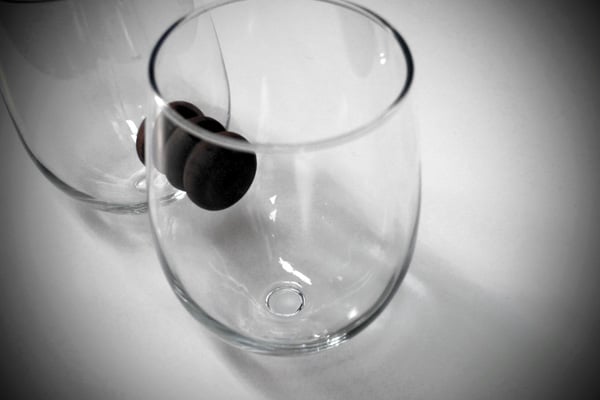

Designs with tea in mind

http://www.yankodesign.com/2011/09/15/a-blooming-cuppa-tea/
Fusioon And The Tea Bag Story -
Coming from a country where tea is not so much of a ceremonial process but just a necessity of life, concepts involving the right amount of steeping and fussing amuse me no end. Adding to my list of fascinating tea stories is the Fusioon Spoon Concept, where an appropriate niche holds the green teabag for centralized dipping, so that it receives an equal amount of water from all sides. The clever design also takes care of the used bag efficiently. Maybe it’s time I acquired some international tea drinking skills, or maybe I should just stick to instant coffee! Designer: AMOR DE MADRE
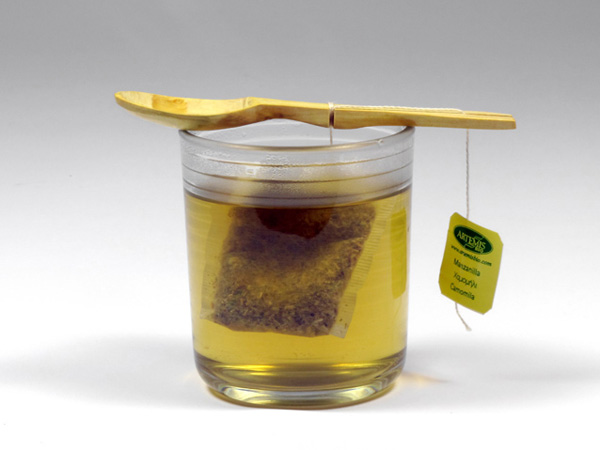
Nasty tea set
Don’t Mess With This Tea Set!
This tea set has got a nasty attitude in all the right ways. Designer José Paulo Alves Corceiro was inspired to design a set of china that wasn’t boring or dainty, and the Nasty Set is anything but. The porcelain set’s grimacing faces and unorthodox shape recall the iconography of comics, animated film, and video games. Designer: José Paulo Alves Corceiro
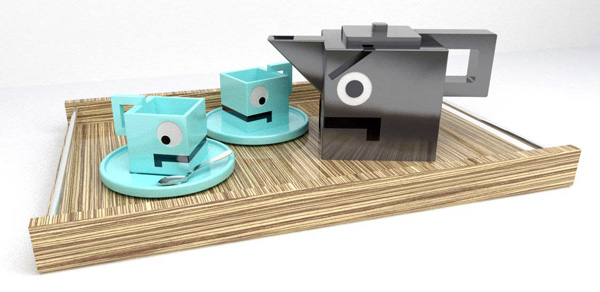
Sweater Up My Dears and Bodum maker
Ah, the weather is a perfect reflection of what Christmas should feel like, and I am mighty glad to get the wood fire roaring. Team it up with brand new sweaters and this wonderful Sweater Mug to drink hot Coco from! Cuddle up to this delightful cup and if you feel generous, send me the ones in pink and blue!
Available: At the YD Store [ Buy it Here ]


and The Bodum Coffee & Tea Maker is unlike any I’ve seen before. A borosilicate glass reservoir & beverage filter are integrated as detachable modules, making the coffee or tea completely spill-proof. The engagement of brewing process is revealed in one central, elegant device. A new chapter in both coffee & tea culture! Designer: Sunny Ting Wai Wong

Tea Bag Lights Up your Night, Literally
Surely you caffeine addicts will agree, coffee truly is the sexually oriented drink – It picks you up! It illuminates your world, if I may say so. Designer / Bookmark Maker Wonsik Chae takes this concept to an elegant level by making the drop-in tea bag light up your environment chemically. For those whose eyes are sensitive to brightness in the mornings, I recommend a different cup. For those who love lamp(s), drop it!
As the tea bag empties its taste into a tea cup, so does the “Lighting Bag” empty its light into any fluid-holding container. What Wonsik hopes to accomplish with this project is to tear down the idea that creating forms from which light can be projected must be a difficult task – he wants light forms to flow easily.
Having a manifesto for your industrial design project can be a dangerous rope to walk – what do you make of Wonsik’s liquid light concept?
P.S. I must say, I LOVE the URL of Wonsik’s portfolio, as it plays on the pronunciation of the name:http://www.onesik.com/, and be sure to see the Contact page – it’s beautiful!
Designer: Wonsik Chae
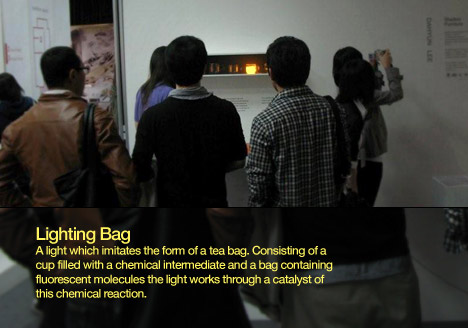
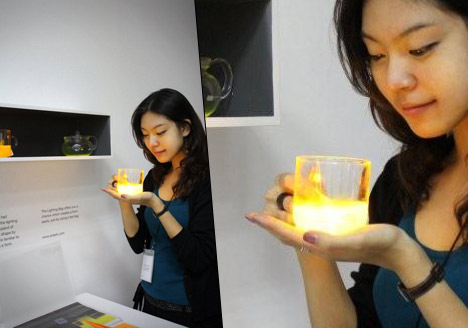
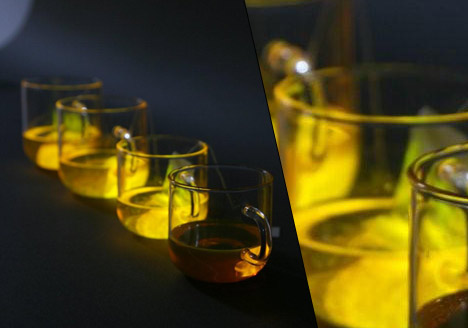
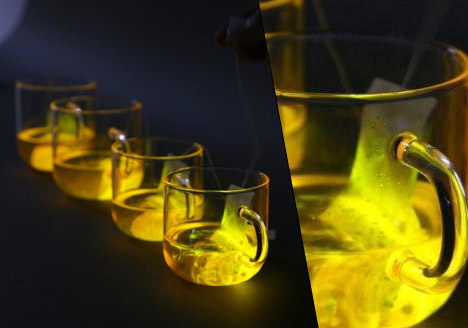
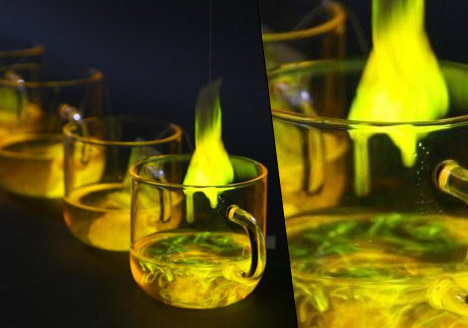
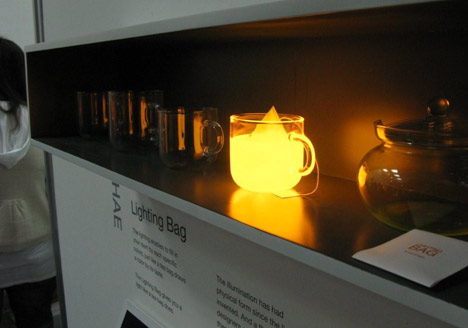
re bloged from http://www.yankodesign.com/2009/03/05/tea-bag-lights-up-your-night-literally/








